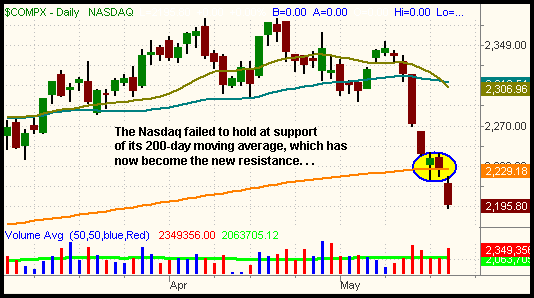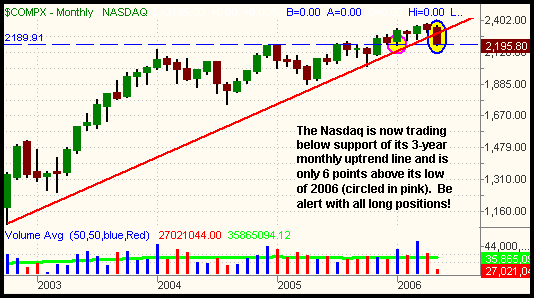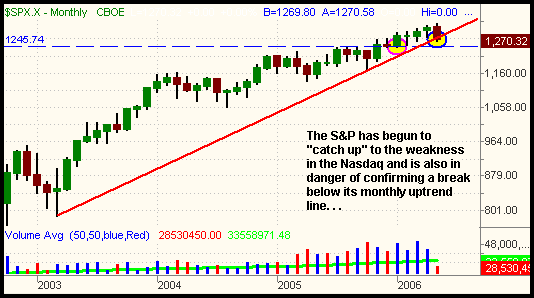The selloff that began on May 11 gained momentum yesterday, as the major indices suffered another round of severe losses on higher volume. The broad market began the day with an opening gap down, but failed to recover from it, triggering another slide that resulted in a steady intraday downtrend. Contrary to recent action, the Dow Jones Industrial Average posted the worst loss of the major indices, closing 1.9% lower. The S&P 500 similarly lost 1.7%, while the Nasdaq Composite dropped 1.5%. Again, there was nowhere for the bulls to hide, as small and mid-cap stocks fared no better. The Russell 2000 Index gave up 1.6% and the S&P Midcap Index lost 1.8%. Each of the major indices opened at their intraday highs and closed at their lows, continuing the refreshing change from a choppy, erratic market to a steadily trending market that is ideal for short-term "trend traders."
Turnover surged higher across the board yesterday, tacking on another session of institutional selling to the count. Total volume in the NYSE increased by 23%, while volume in the Nasdaq was 15% higher than the previous day's level. All but one day of the broad market's losses since the selloff began has been on higher volume. Even when stocks eventually bounce, so much overhead supply has been created by the numerous "distribution days" that the market is unlikely to retrace much of its losses, at least in the short-term. Worse than yesterday's high volume was the extremely negative market internals. In the NYSE, declining volume trounced advancing volume by a margin of more than 9 to 1! The ratio in the Nasdaq was negative by 5 to 1. On a typical day of losses in a choppy or uptrending market, it is common to see this ratio by negative by 2 to 1 or even up to 4 to 1, but advancing volume in the NYSE was nearly non-existent yesterday. You need to go all the way back to the year 2000, when stocks began collapsing from the amazing bull run of the late '90s to see such extreme ratios. We won't speculate as to whether this is the start of an equally nasty bear market, but suffice it to say that, unless you are a traditional "buy and pray" investor, we definitely think it is now wrong to be long for anything more than a quick bounce off a key support level.
On a technical level, several key events took place in the broad market yesterday. The Nasdaq, which tried to hold at support of its 200-day moving average in the previous two sessions, closed firmly below it. This is significant because most institutional traders view the 200-day moving average as a long-term "line in the sand" that determines whether or not they are net buyers or sellers of stock. The 50-day moving average has a similar significance, but is usually associated as a sentiment indicator for the intermediate-term. Remember that a prior support level becomes the new resistance level after the support is broken, so expect the Nasdaq to have difficulty recovering back above its 200-day MA in the near-term:

Of greater concern is that the Nasdaq also closed below support of its long-term monthly uptrend line. Since the market bottomed out in October 2002, the Nasdaq has been steadily moving higher, having its most recent anchor of its uptrend line with the low of October 2005. However, the Nasdaq is now sitting squarely below that uptrend line, confirming the bearishness of its fall below the 200-day moving average. As the dashed horizontal line on the weekly chart below illustrates, the Nasdaq is now only six points above its 2006 low. A break below that level will confirm the break of the monthly uptrend line:

If you rarely study the longer-term monthly charts of the major indices, now is probably a good time to do so. Like the Nasdaq, the S&P 500 also closed yesterday below support of its multi-year uptrend line, but only by a small margin. As of yesterday's close, the S&P is now only 2% above its 2006 low, so watch the 1,245 level as a major area of support that needs to hold. If that level is broken, it could lead to a pretty bearish remainder of the year:

On the ETF front, low-risk long setups are now few and far between. There are a few sectors such as Semiconductors in which the selling is probably overdone in the short-term, but the overly bearish sentiment in the market right now means that you need to be quick and disciplined if attempting to play any bounces on the long side. Instead, you now have a much better risk/reward of waiting patiently for the broad market and weak sectors to bounce, then selling them short when they begin to roll over again. We have our eyes on a few such ETFs and will keep you abreast of setups we like when they present ideal entry points in the coming weeks.
Although the recent market environment is not ideal for long-term investments, it is a welcome reprieve from the months of chop and lack of follow-through that has made it difficult for short-term "trend traders" such as ourselves to profit. Case in point is that our short position in the S&P Select Energy SPDR (XLE) actually hit its price target yesterday! Despite having provided quality setups to subscribers for months, it has been a while since a trade in either direction trended all the way to our original price target. We covered the remaining shares of the XLE short position for a gain of nearly 5 points (7.8%). Our only open position is now the iShares Russell 2000 (IWM), which we sold short on May 16. We have also removed the long setup in the Biotech HOLDR (BBH) from our watchlist.
Deron Wagner is the Founder and Head Trader of both Morpheus Capital LP, a U.S. hedge fund, and Morpheus Trading Group, a trader education firm launched in 2001 that provides daily technical analysis of the leading ETFs and stocks. For a free trial to the full version of The Wagner Daily or to learn about Wagner's other services, visit MorpheusTrading.com or send an e-mail to deron@morpheustrading.com.